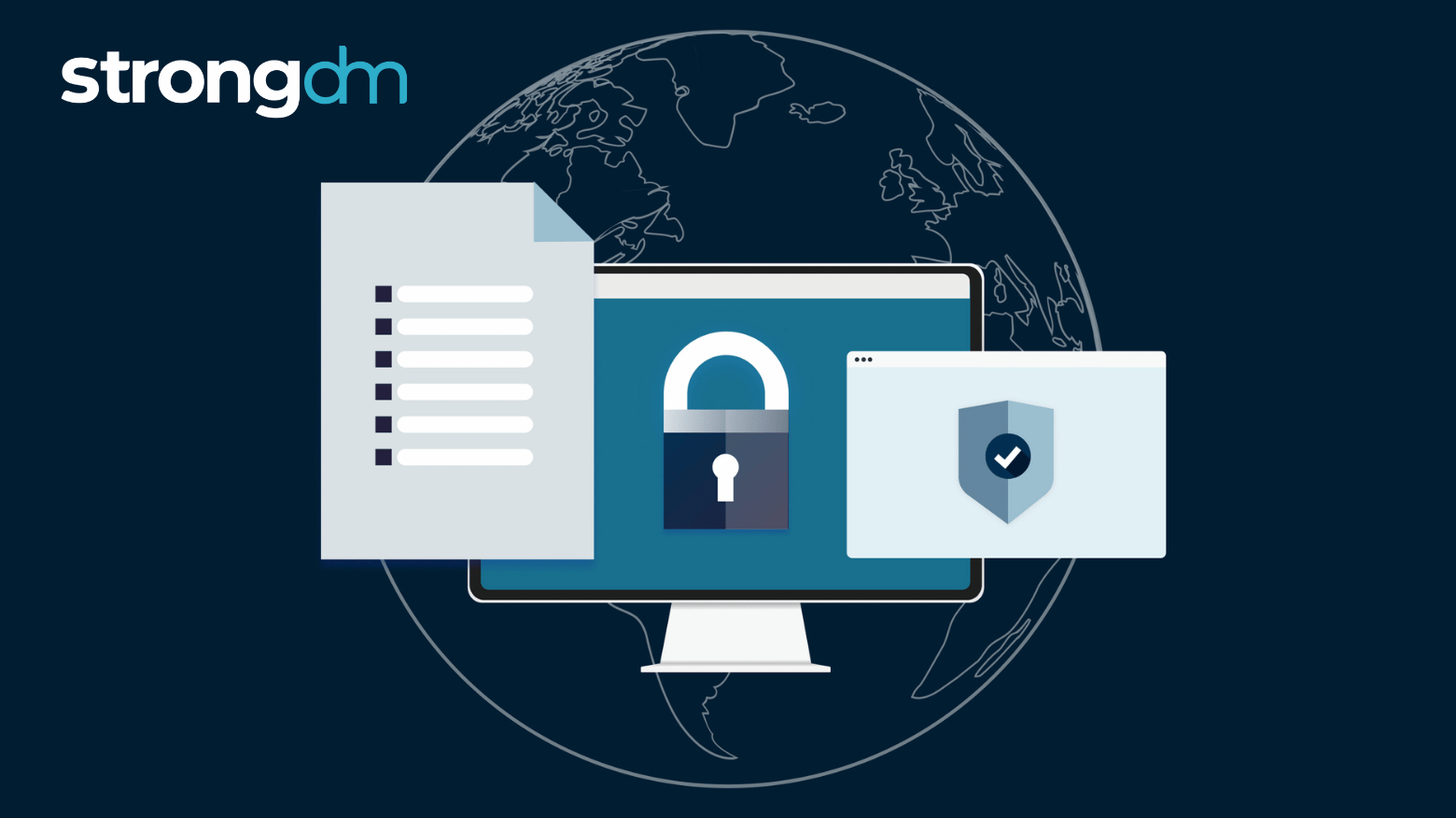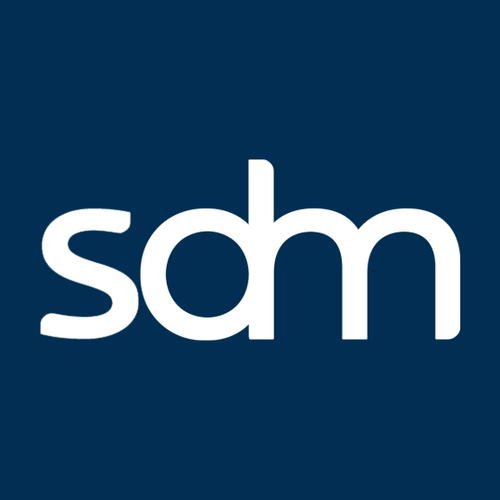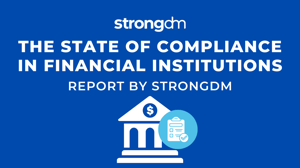

Written by
StrongDM TeamLast updated on:
August 21, 2025Reading time:
Contents
Built for Security. Loved by Devs.
- Free Trial — No Credit Card Needed
- Full Access to All Features
- Trusted by the Fortune 100, early startups, and everyone in between
Security breaches make headlines, while compliance audits keep teams on edge. The pressure to protect data and meet regulatory requirements is mounting—and often, the lines between security and compliance get blurred. Are they the same thing? Are they working in tandem—or pulling in different directions?
This post breaks it down: what security and compliance are, how they intersect, where they differ, and most importantly, how your organization can align the two effectively.
What Is Security?
Security is about protecting your systems, networks, and data from unauthorized access, misuse, or destruction. It encompasses a wide range of defenses—from encryption and firewalls to endpoint protection and identity access controls.
At its core, security is built around the CIA Triad:
- Confidentiality – ensuring data is only accessible by those with permission.
- Integrity – maintaining the accuracy and reliability of data.
- Availability – making sure systems and data are accessible when needed.
Security is continuous, adaptive, and often invisible when done right. It’s not a box you check—it’s a mindset.
💡Make it easy: StrongDM enforces least-privilege access and provides real-time session logs across infrastructure, making security seamless and continuous.
What Is Compliance?
Compliance is the practice of adhering to external regulations, industry standards, and internal policies. Think of it as your organization’s legal and ethical GPS.
Compliance frameworks—like HIPAA, GDPR, SOC 2, and ISO 27001—are designed to enforce minimum standards for data protection, privacy, and governance.
Key characteristics of compliance:
- Documentation-heavy
- Audit-driven
- Time-bound (e.g., annual SOC 2 audits)
- Rule-based rather than risk-based
Being compliant means you're following the rules. But that doesn't always mean you're secure.
💡Make it easy: StrongDM generates audit-ready logs automatically, so you can prove compliance with zero guesswork.
Security vs. Compliance: What’s the Difference?
Here's the short version: Security is about protection and risk management. Compliance is about proof and standardization.
Think of security as your organization's active defense system, while compliance serves as your documented playbook of controls and processes. While both aim to protect sensitive data, they approach it from different angles.
| Aspect | Security | Compliance |
|---|---|---|
| Purpose | Protect data and systems | Meet legal and regulatory standards |
| Nature | Proactive, risk-based | Reactive, rule-based |
| Duration | Continuous | Periodic |
| Driven by | Risk tolerance and threat models | Legal, regulatory, and contractual obligations |
| Outcome | Reduced risk | Audit readiness |
💡Make it easy: StrongDM helps you manage both simultaneously—reduce risk and simplify audits from one unified platform.
Where Security and Compliance Align
Security and compliance aren't mutually exclusive. In fact, when done right, they support each other in creating a comprehensive approach to protecting an organization's assets and meeting regulatory requirements.
Shared Goals:
- Protect sensitive data through robust security controls and compliance frameworks
- Ensure privacy and confidentiality of customer information
- Mitigate risk through continuous monitoring and assessment
- Maintain business operations within regulatory guidelines
- Build trust with stakeholders through demonstrated security practices
Common Controls:
- Access controls and identity management systems
- Encryption of data at rest and in transit
- Audit logs and continuous monitoring solutions
- Incident response plans and recovery procedures
- Risk assessments and vulnerability management
- Security awareness training programs
- Change management processes
- Third-party vendor management
These controls fulfill both security objectives and compliance mandates. For example, encrypting sensitive customer data satisfies SOC 2 and GDPR while also preventing data leakage. Similarly, implementing robust access controls helps meet industry standards while protecting against unauthorized access and potential cybersecurity threats.
The overlap between security and compliance creates opportunities for organizations to build efficient, integrated programs that address both requirements simultaneously. By aligning security best practices with compliance requirements, companies can create a stronger overall security posture while maintaining regulatory compliance.
💡Make it easy: StrongDM delivers these shared controls out of the box, making it easy to align security and compliance objectives.
Key Differences Between Security and Compliance
1. Mindset
Security teams think in terms of threats and attackers, focusing on proactive defense and risk mitigation; compliance teams think in terms of frameworks and documentation, emphasizing regulatory adherence and audit preparation.
2. Measurement
You measure security by how well you mitigate risk through continuous monitoring, incident response times, and threat detection rates. You measure compliance by passing an audit, maintaining documentation, and meeting specific regulatory requirements.
3. Responsibility
Security often falls under the CISO with a focus on implementing controls and managing security operations; compliance is often owned by legal, GRC, or privacy teams who oversee regulatory requirements and audit readiness.
4. Approach
Security teams adopt a dynamic, risk-based strategy that evolves with emerging threats, while compliance teams follow structured, predetermined frameworks and checklists.
5. Timeline
Security requires constant vigilance and real-time response to threats, whereas compliance often operates on fixed schedules with periodic assessments and audits.
💡Make it easy: StrongDM supports both approaches by combining real-time monitoring with automated compliance documentation.
Common Challenges in Aligning Security and Compliance
- Siloed teams – Security and compliance often operate independently, leading to miscommunication and duplicated efforts. This fragmentation results in inconsistent policies, conflicting priorities, and gaps in risk coverage that neither team fully addresses.
- Limited visibility – Without full insight into infrastructure and access, it's hard to enforce either. Organizations struggle with fragmented monitoring tools, incomplete asset inventories, and blind spots in their security posture that make both continuous security monitoring and compliance reporting more difficult.
- Resource constraints – Organizations may struggle to implement controls that satisfy both security and compliance. Limited budgets force teams to choose between security tools and compliance frameworks, while staffing shortages mean key roles go unfilled or teams become overwhelmed managing both requirements.
- Shadow IT – Unmanaged services increase risk and make compliance reporting harder. When employees bypass official channels, they create security vulnerabilities and compliance gaps that neither team can effectively track or control.
- Evolving requirements – As regulations change and new security threats emerge, teams struggle to maintain alignment between compliance frameworks and security controls. This creates a constant need to update documentation, modify controls, and re-train staff.
- Technology complexity – Multiple security tools and compliance platforms often lack integration, creating data silos that hinder both real-time security monitoring and compliance reporting. This fragmentation increases costs while reducing operational efficiency.
💡Make it easy: StrongDM unifies access across environments, giving teams full visibility and reducing tool sprawl.
How to Align Security and Compliance in Your Organization
Alignment isn't about choosing one over the other—it's about making them work together. Here's how:
- Foster collaboration between security and compliance teams through regular joint planning sessions, shared metrics, and unified reporting structures.
- Use compliance requirements as a guide for prioritizing security investments and build controls that satisfy both security needs and regulatory demands.
- Automate reporting and access audits to reduce human error and increase accuracy while maintaining continuous compliance monitoring.
- Conduct regular risk assessments—not just to check a box, but to stay ahead of evolving threats and ensure controls remain effective.
- Implement integrated governance frameworks that address both security controls and compliance requirements simultaneously.
- Establish clear communication channels between security and compliance teams to ensure rapid response to both security incidents and compliance changes.
- Create unified documentation that serves both security and compliance needs, reducing duplicate efforts and ensuring consistency.
- Develop cross-functional training programs that help teams understand both security best practices and compliance requirements.
- Build automated workflows that incorporate both security controls and compliance checks into daily operations.
- Regularly review and update policies to ensure they reflect current security threats and compliance mandates while maintaining operational efficiency.
💡Make it easy: StrongDM automates access controls, audit trails, and evidence collection—aligning teams without added overhead.
Cloud Security and Compliance
As organizations migrate to the cloud, the intersection of security and compliance becomes even more critical. Cloud environments introduce unique challenges that blur the traditional boundaries between security controls and compliance requirements.
Key considerations for cloud security and compliance:
- Shared Responsibility Model: Cloud providers secure the infrastructure, but you're responsible for securing what runs on it. Understanding this division is crucial for both security implementation and compliance reporting.
- Dynamic Environments: Cloud resources spin up and down automatically, making traditional security controls and compliance documentation more complex.
- Data Sovereignty: Cloud storage can span multiple geographic regions, each with its own regulatory requirements and compliance frameworks.
- Access Management: Cloud environments require sophisticated identity and access controls that satisfy both security best practices and compliance mandates.
- Continuous Monitoring: Cloud infrastructure demands real-time visibility for both security threat detection and compliance evidence collection.
The challenge isn't just securing cloud assets—it's proving that security through documented controls and automated compliance reporting. Organizations need tools and processes that address both aspects simultaneously, ensuring protection while maintaining audit readiness across their entire cloud footprint.
💡Make it easy: StrongDM supports secure access and compliance reporting across cloud, hybrid, and on-prem environments—no blind spots, no gaps.
Real-World Example: Compliance ≠ Security
A company might pass a SOC 2 audit and still suffer a breach days later. Why? Because security gaps like unmonitored access or unmanaged credentials weren't addressed, even though the paperwork was in place. This happens when organizations focus solely on meeting compliance checkboxes rather than implementing comprehensive security controls.
Consider the 2013 Target data breach—despite being PCI DSS compliant, the retail giant suffered a massive security incident affecting 40 million customers. The company had met compliance requirements on paper but failed to detect and respond to real security threats in their environment. This illustrates how compliance documentation alone doesn't guarantee robust security.
On the flip side, companies with strong security fundamentals often breeze through audits—because their infrastructure is already aligned with best practices. These organizations typically implement continuous monitoring, regular risk assessments, and proactive security measures that go beyond basic compliance requirements. When audit time comes, they're not scrambling to fill gaps—they're simply documenting their existing security controls.
💡Make it easy: StrongDM helps you build secure-by-default environments that are always audit-ready.
How StrongDM Helps You Align Data Security and Compliance
StrongDM bridges the gap between security and compliance by simplifying secure infrastructure access and automated evidence collection:
- Granular Access Controls: Grant access to databases, servers, and Kubernetes clusters on a need-to-know basis. Every action is logged in real time.
- Audit-Ready Logs: Generate detailed, tamper-proof logs of who accessed what, when, and how—making compliance evidence collection effortless.
- Role-Based Access Management (RBAC): Enforce least-privilege access across your stack with just-in-time provisioning.
- Security That Scales: With StrongDM, security is baked into your workflows—so you’re always compliant by default, not just during audit season.
Security and compliance are two sides of the same coin. One protects, the other proves. When they’re aligned, you not only reduce risk—you build trust with customers, partners, and regulators alike.
Don’t treat security and compliance as competing forces. Treat them as collaborators.
Want to simplify both? Book a demo and see how StrongDM can help.
Security and Compliance: Frequently Asked Questions
What is information security compliance?
It’s the practice of following laws, regulations, and standards that require organizations to protect data and systems.
What is security compliance management?
It’s the process of implementing, monitoring, and maintaining security controls that meet regulatory and policy requirements.
Why are security and compliance important?
They protect sensitive data, reduce risk, meet legal obligations, and build trust with customers and regulators.
What are security compliance standards?
They are frameworks like SOC 2, ISO 27001, HIPAA, and GDPR that define minimum security and privacy requirements.
What is the role of a security and compliance officer?
They ensure the organization’s security controls align with compliance requirements, manage audits, and reduce risk exposure.
Next Steps
StrongDM unifies access management across databases, servers, clusters, and more—for IT, security, and DevOps teams.
- Learn how StrongDM works
- Book a personalized demo
- Start your free StrongDM trial

Categories:

About the Author
StrongDM Team, Zero Trust Privileged Access Management (PAM), the StrongDM team is building and delivering a Zero Trust Privileged Access Management (PAM), which delivers unparalleled precision in dynamic privileged action control for any type of infrastructure. The frustration-free access stops unsanctioned actions while ensuring continuous compliance.
You May Also Like




